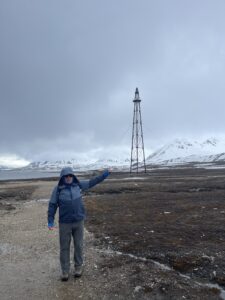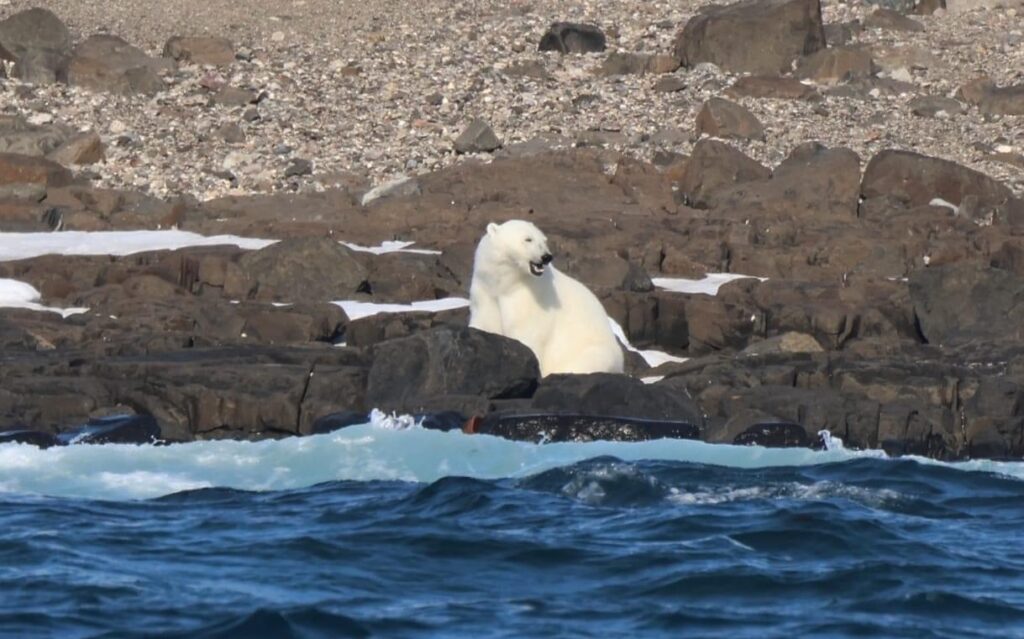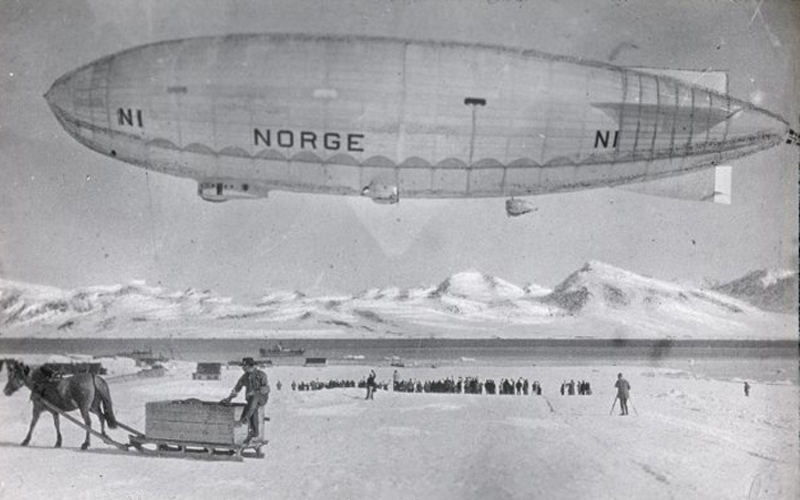Author Buddy Levy shares his chilly experience in Ny Ålesund, Norway, where he gathered research materials for his book, Realm of Ice and Sky: Triumph, Tragedy, and History’s Greatest Arctic Rescue.

Wind whips my face as I stand beneath the 115-foot-high steel mooring mast at Ny Ålesund, Svalbard. Though it is mid-June, snow covers the mountains across the Kongsfjorden (Kings Fjord), and I gaze in awe at the rugged peaks erupting from the sea and disappearing into the thick clouds. I breathe in the cool arctic air, close my eyes, and imagine the Norge, a 350-foot-long dirigible, tethered to the mast at the nose cone, its engines whirring. Aboard the airship, Italian Umberto Nobile—who designed the Norge—is at the controls, checking gauges and valves. Norwegian explorer-extraordinaire Roald Amundsen peers from the front window, his eagle eyes squinted, cast towards their destination: the North Pole.
I’ve come to Ny Ålesund—today the northernmost permanently occupied town in the world at just shy of 79° N—to do research for my book Realm of Ice and Sky. The book is about the first explorers to attempt reaching the North Pole not by the traditional dog and sled method, but by means of hydrogen-filled dirigibles, or airships. The feat was first attempted in the early 1900s by American Walter Wellman, who departed from Danes Island, fifty miles north of Ny Ålesund. In 1926, Roald Amundsen, Umberto Nobile, and American Lincoln Ellsworth attempted it from the very spot where I’m standing. Between the years 1906-1928, this rugged, wind and snow and ice-bound place—then called Spitsbergen—was the staging area for some of the most audacious and dangerous expeditions ever mounted in the Arctic. I’ve come to see and feel and experience the region for myself so that I might better understand and describe it for my readers.
In writing narrative history, one of the most rewarding and sometimes thrilling aspects of my research involves going to the places I’m writing about and retracing parts of the routes of the explorers I’m chronicling.
I make these journeys for a number of reasons. One, I love to travel to far-flung places for adventure and new experiences. And I believe being physically in the locales I’m writing about benefits my books immensely, providing the reader with a visceral first-hand, ground-level view that, if I do my job and write well, gives the reader a real sense of what it might have been like for the explorers I’m writing about. While traveling the
routes and environs, I carry with me and read the first-hand accounts (diaries, logbooks, published sources) of the explorers and participants to help transport me back in time.

I spent three weeks in Svalbard, Norway in June 2023. Svalbard is a 24,000-square-mile archipelago of fjords and glaciers and frozen tundra about halfway between mainland Norway and the North Pole. It’s home to reindeer, Arctic foxes, puffins, and innumerable shorebirds and waterfowl. Fin, beluga, and minke whales feed on the rich supply of krill, small fish, and plankton. Notably, hundreds of endangered and protected polar bears roam the shorelines, constantly looking for food. The region is enormous and remote and dangerous.
There is only one designated campground in Svalbard, called Longyearbyen Camping, which is where I spent my first week. It’s the world’s northernmost official campground, and I wanted to sleep in a tent so I could hear the soundscape and feel the Arctic tundra beneath me. I arrived with some trepidation, having learned that in 2020, tragically, a Dutch man had been dragged from his tent and mauled to death at this very campground. I slept in a canvas, pyramidal-shaped “Scott tent,” an added eerie irony as this tent style was the exact type that Robert Falcon Scott died in during his return from the South Pole in 1912.
My first few nights were fitful, owing to the midnight sun, the cackling of nesting barnacle geese, the piercing cries of Arctic terns, and my near-constant fear of polar bears. The electric fence encircling the campground—installed after the horrific 2020 incident—offered some solace. Still, every huff of wind ruffling the tent flap I feared was a hungry polar bear nosing or pawing its way in. I shivered in my tent at 28°, unarmed,1* naked and afraid, humbled and unsettled at being #2 in the food chain.
My research goals for the trip—in addition to visiting the Svalbard Museum and the Polar Museum, where much information on Wellman/Amundsen/Nobile are housed—included getting out on the water near glaciers, trekking in the mountains for expansive vistas such as were seen by the explorers, and to get to Ny Ålesund.
In many ways, the highlight of the trip was Ny Ålesund. It was here, in the remote outpost that is now part international polar research center and part historical museum, that I got closest to the intrepid aeronauts who populate my book, Realm of Ice and Sky. Much of the town (then called Kings Bay) still stands as it did when Roald Amundsen and Umberto Nobile and American Lincoln Ellsworth (who helped finance the expedition) were here in 1926, bent on making history. The Amundsen Villa, a tidy red house with white trim and a black roof where Amundsen stayed, remains well-preserved.
As I strolled around the northernmost town in the world, I conjured it as it would have looked on the blustery morning of May 11, 1926, when some 350 people were there. Inside the immense airship hangar, Nobile is anxiously shouting final instructions to the dozen-member flight crew and testing the engines. Ground crews are loading emergency gear—snowshoes and skis and food—into the airship’s storage. Navigators take their places for steering, riggers check the valves, ballonets, and gas envelope of the twenty-ton Norge. The mechanics climb into the gondolas to maintain the three 250-horsepower engines capable of propelling the airship at proper cruising speed of fifty to sixty miles per hour for the proposed 2,500-mile flight.
I paused my reverie and walked over to the large bronze bust of Amundsen which sits in the center of town. The bust has him in hooded anorak, and the sculpture faithfully renders his beaked nose, raptor’s gaze, and crevassed face. After snapping a selfie next to the bust, I take out some notes that include a description, written by ground crew member Norwegian Bernt Balchen, who recorded the scene:
Amundsen is last to reach the Norge … with a roll of charts under his arm, like a scientist quietly entering his laboratory. He wears a light windbreaker, a blue flying helmet, and his familiar canvas-topped mukluks … He pauses at the foot of the steps and the meteorologist hands him a final weather reading. He studies it and lifts his carved face for a moment to the sky, weighing his decision. It is a face that lived a thousand years ago, and will live a thousand years from now.**
Inspired, I shut my eyes and returned to my musings:
Amundsen takes his place by the large window of the control gondola and Nobile gives the order to guide the Norge backward from the hangar. Once aloft, they hover for a few minutes one hundred feet above a snowfield near the shore, checking weight and balance; then the engines are started, and the ground crew release the tethers. Everyone in Kings Bay stares in awe at the airship’s whiteish underbelly and silvery sides suspended above the Arctic waters and lustrous glaciers. They are witnessing a magnificent engineering marvel: the pressurized airship is taut and sleek, reinforced with metal frames at the nose and tail, with a flexible tubular metal keel connecting the two.

As the airship rises, the ground crew waves and cheers and doffs their hats. The Norge climbs to 1,200 feet as auks and gulls fly from the high cliff walls, startled from their rookeries by the strange flying machine. Nobile steers the dirigible toward the open mouth of the bay at fifty miles per hour, while Amundsen and Ellsworth look out their window as Kings Bay recedes in the distance and is engulfed by mist. They are headed north into the unknown…
And I am headed home. I have a book to write.
* I was unarmed because in Svalbard, to carry a firearm one must be licensed by the Governor of Svalbard—a process that takes at least four weeks, and I had not organized it ahead of time. Also, most visitors travel with guides who carry rifles. In fact, traveling without guides with flares and firearms is highly discouraged and frankly foolish.
** From Bernt Balchen, Come North With Me, 47 (Qtd in Buddy Levy, Realm of Ice and Sky, 154-55).
Excerpt from an article originally published on Buddy Levy’s Substack.

